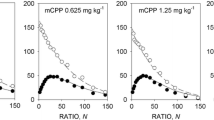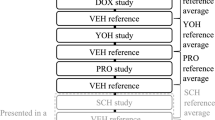Abstract
Rationale
Performance on progressive-ratio schedules has been proposed as a means of assessing the effects of drugs on motivation. We have adopted a mathematical model proposed by Killeen to analyse the effects of drugs acting at 5-HT1A receptors on progressive-ratio performance. According to this model, the relationship between response rate and ratio size is described by a bitonic (inverted-U) function. One parameter of the function, a, expresses the motivational or "activating" effect of the reinforcer (duration of activation of responding produced by the reinforcer), whereas another parameter, δ, expresses the minimum time needed to execute a response and is regarded as an index of "motor capacity".
Objective
To examine the effect of the selective 5-HT1A receptor agonist 8-OH-DPAT [8-hydroxy-2-(di-n-propylamino)tetralin] and the antagonist WAY-100635 [N-[2-(4-[2-methoxyphenyl]-1-piperazinyl)ethyl]-N-2-pyridinylcyclo-hexanecarboxamide] on progressive-ratio schedule performance.
Methods
Sixteen rats responded for a food-pellet reinforcer on a time-constrained progressive-ratio schedule (55-min sessions). In phase 1, they received single doses (s.c.) of 8-OH-DPAT (25, 50, 100, 200 μg kg−1, four treatments at each dose) or the vehicle (0.9% saline solution). In phase 2, they received WAY-100635 (30, 100, 300 μg kg−1) according to the same regimen. In phase 3, they received 8-OH-DPAT (100 μg kg−1) alone or in combination with WAY-100635 (30 μg kg−1). 8-OH-DPAT dose dependently increased the value of a, significant increases being seen with the 50, 100 and 200 μg kg−1 doses. The highest dose also increased δ. WAY-100635 did not significantly alter either a or δ. WAY-100635 significantly attenuated the effect of 8-OH-DPAT on both a and δ.
Conclusions
The results suggest that 8-OH-DPAT enhanced the activating effect of the reinforcer (the highest dose may also have induced motor debilitation). The finding that the effect of 8-OH-DPAT on a was attenuated by WAY-100635 implicates 5-HT1A receptors in this effect. The results are consistent with previous reports that 8-OH-DPAT facilitates feeding and food-reinforced operant responding in rats and suggest that these effects may be brought about by an increase in food motivation.







Similar content being viewed by others
References
Aberman JE, Ward SJ, Salamone JD (1998) Effects of dopamine antagonists and accumbens dopamine depletions on time-constrained progressive-ratio performance. Pharmacol Biochem Behav 61:341–348
Arnold J, Roberts DCS (1997) A critique of fixed and progressive ratio schedules used to examine the neural substrates of drug reinforcement. Pharmacol Biochem Behav 57:441–447
Bantick RA, Deakin JFW, Grasby PM (2001) The 5-HT1A receptor in schizophrenia: a promising target for novel atypical neuroleptics? J Psychopharmacol 15:37–46
Barnes NM, Sharp T (1999) A review of central 5-HT receptors and their function. Neuropharmacology 38:1083–1152
Barr AM, Philips AG (1998) Withdrawal following repeated exposure to d-amphetamine decreases responding for a sucrose solution as measured by a progressive ratio schedule of reinforcement. Psychopharmacology 141:99–106
Bendotti C, Samanin R (1986) 8-hydroxy-2-(di-n-propylamino)tetralin (8-OH-DPAT) elicits eating in free-feeding rats by acting on central serotonin neurons. Eur J Pharmacol 121:147–150
Bizo LA, Killeen PR (1997) Models of ratio schedule performance. J Exp Psychol [Anim Behav Proc] 23:351–367
Body S, Chiang T-J, Mobini S, Ho M-Y, Bradshaw CM, Szabadi E (2001) Failure of central 5-hydroxytryptamine depletion to alter the effect of 8-hydroxy-2-(di-n-propylamino)tetralin (8-OH-DPAT) on timing performance on the free-operant psychophysical procedure. Psychopharmacology 158:305–313
Body S, Kheramin S, Mobini S, Ho M-Y, Velazquez-Martinez DN, Bradshaw CM, Szabadi E (2002) Antagonism by WAY-100635 of the effects of 8-OH-DPAT on performance on a free-operant timing schedule in intact and 5-HT depleted rats. Behav Pharmacol 13:603–614
Cheeta S, Brooks S, Willner P (1995) Effects of reinforcer sweetness and the D2/D3 antagonist raclopride on progressive ratio operant responding. Behav Pharmacol 6:127–132
Currie PJ, Fletcher PJ, Coscina DV (1994) Administration of 8-OH-DPAT into the midbrain raphe nuclei: effects on medial hypothalamic NE-induced feeding. Am J Physiol 266:1645–1651
Currie PJ, Coscina DV, Fletcher PJ (1998) Reversal of fenfluramine and fluoxetine anorexia by 8-OH-DPAT is attenuated following raphe injection of 5,7-dihydroxytryptamine. Brain Res 800:62–68
Dekeyne A, Rivet J-M, Gobert A, Millan MJ (2001) Generalization of serotonin (5-HT)1A agonists and the antipsychotics, clozapine, ziprasidone and S16924, but not haloperidol, to the discriminative stimuli elicited by PD128,907 and 7-OH-DPAT. Neuropharmacology 40:899–910
Dourish CT, Kennett GA, Curzon G (1986) Effects of putative 5-HT1A agonists buspirone and ipsapirone and of the putative 5-HT1B agonists RU-24969 and quipazine on food intake in the rat. Psychopharmacology 89:S12
Evenden J, Ryan C, Palejko W (1995) The effects of repeated treatment with 8-hydroxy-2-(di-n-propylamino)tetralin (8-OH-DPAT) on the lever press responding of the rat under FI and DRL schedules of food reinforcement. Psychopharmacology 120:81–92
Ferguson SA, Paule MG (1997) Progressive ratio performance varies with body weight in rats. Behav Proc 40:177–182
Fletcher PJ (1991) Dopamine receptor blockade in nucleus accumbens or caudate nucleus differentially affects feeding induced by 8-OH-DPAT injected into dorsal or median raphe. Brain Res 552:181–189
Fletcher PJ, Tampakeras M, Yeomans JS (1995) Median raphe injections of 8-OH-DPAT lower frequency thresholds for lateral hypothalamic self-stimulation. Pharmacol Biochem Behav 52:65–71
Gilbert F, Dourish CT (1987) Effects of the novel anxiolytics gepirone, buspirone and ipsapirone on free feeding and feeding induced by 8-OH-DPAT. Psychopharmacology 93:349–352
Hamill S, Trevitt JT, Nowend KL, Carlson BB, Salamone JD (1999) Nucleus accumbens dopamine depletion and time-constrained progressive ratio performance: effects of different ratio requirements. Pharmacol Biochem Behav 64:21–27
Harrison AA, Markou A (2001) Serotonergic manipulations both potentiate and reduce brain stimulation reward in rats: involvement of serotonin-1A receptors. J Pharmacol Exp Ther 297:316–325
Hartley JE, Foster EA, Fletcher A (1994) The effects of WAY-100635, the selective 5-HT1A receptor antagonist on feeding induced by buspirone, gepirons, ipsapirone and clonidine in the rat. Br J Pharmacol 113:125P
Herrnstein RJ (1970) On the law of effect. J Exp Anal Behav 13:243–266
Hodos W (1961) Progressive ratio as a measure of reward strength. Science 134: 943–944
Hodos W, Kalman G (1963) Effects of increment size and reinforcer volume on progressive ratio performance. J Exp Anal Behav 6:389–392
Hoyer D, Hannon JP, Martin GR (2002) Molecular, pharmacological and functional diversity of 5-HT receptors. Pharmacol Biochem Behav 71:533–554
Hutson PH, Dourish CT, Curzon G (1986) Neurochemical and behavioural evidence for mediation of the hyperphagic action of 8-OH-DPAT by 5-HT cell body autoreceptors. Eur J Pharmacol 129:347–352
Killeen PR (1994) Mathematical principles of reinforcement. Behav Brain Sci 17:105–172
Mobini S, Chiang T-J, Ho M-Y, Bradshaw CM, Szabadi E (2000) Comparison of the effects of clozapine, haloperidol, chlorpromazine and d-amphetaime on performance on a time-constrained progressive ratio schedule and on locomotor behaviour in the rat. Psychopharmacology 152:47–54
Montgomery AMJ, Grottick AJ (1999) Neurotransmitter system interactions revealed by drug-induced changes in motivated behavior. Pharmacol Biochem Behav 62:643–657
Montgomery AMJ, Rose IC, Herberg LJ (1991) 5-HT1A agonists and dopamine: the effects of 8-OH-DPAT and buspirone on brain-stimulation reward. J Neural Transm 83:139–148
Newman-Tancredi A, Gavaudan S, Conte C, Chaput C, Touzard M, Verriele L, Audinot V, Millan MJ (1998) Agonist and antagonist actions of antipsychotic agents at 5-HT1A receptors: a [35S]GTPγS binding study. Eur J Pharmacol 355:245–256
Roberts DCS, Richardson NR (1992) Self-administration of psychomotor stimulants using progressive ratio schedules of reinforcement. In: Boulton A, Baker G, Wu PH (eds) Neuromethods, vol 24. Animal models of drug addiction. Humana, Totowa, NJ, pp 233–269
Rowlett JK (2000) A labor–supply analysis of cocaine self-administration under progressive ratio schedules: antecedents, methodologies, and perspectives. Psychopharmacology 153:1–16
Simansky KJ (1996) Serotonergic control of the organization of feeding and satiety. Behav Brain Res 73:37–42
Skjoldager P, Pierre PJ, Mittleman G (1993) Reinforcer magnitude and progressive ratio responding in the rat: effects of increased effort, prefeeding, and extinction. Learn Motiv 24:303–343
Stafford D, LeSage MG, Glowa JR (1998) Progressive-ratio schedules of drug delivery in the analysis of drug self-administration: a review. Psychopharmacology 139:169–184
Stewart WJ (1975) Progressive ratio reinforcement schedules: a review and evaluation. Aus J Psychol 27:9–22
Thomas DR, Middlemiss DN, Taylor SG, Nelson P, Brown AM (1999) 5-CT stimulation of adenylyl cyclase activity in guinea-pig hippocampus: evidence for involvement of 5-HT7 and 5-HT1A receptors. Br J Pharmacol 128:158–164
Wogar MA, Bradshaw CM, Szabadi E (1991) Evidence for an involvement of 5-hydroxytrytaminergic neurones in the maintenance of operant behaviour by positive reinforcement. Psychopharmacology 105:119–124
Wong DT, Reid LR (1987) Fenfluramine antagonizes the stimulation of food intake induced by the putative 5-hydroxytryptamine1A agonist, ipsapirone, in non-fasted rats. J Pharm Pharmacol 39:570–571
Acknowledgements
This work was supported by the Wellcome Trust. We are grateful to Ms. V.K. Pincott for skilled technical help.
Author information
Authors and Affiliations
Corresponding author
Rights and permissions
About this article
Cite this article
Ho, MY., Body, S., Kheramin, S. et al. Effects of 8-OH-DPAT and WAY-100635 on performance on a time-constrained progressive-ratio schedule. Psychopharmacology 167, 137–144 (2003). https://doi.org/10.1007/s00213-002-1375-9
Received:
Accepted:
Published:
Issue Date:
DOI: https://doi.org/10.1007/s00213-002-1375-9




